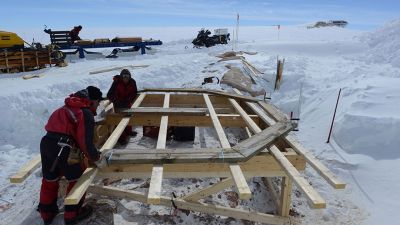
Carrying on in spite of the weather
Bad weather has moved into the Queen Maud Land, and the BELARE team must grin and bear it while continuing with the work plan of the season.
Weathering the storm
An easterly wind is still blowing at a brisk 20 knots (37 km/h) atop Utsteinen Ridge. The sky is overcast. Tomorrow the weather will be a little better according to our meteorologists, but conditions will get worse again the day after tomorrow.
For those of us based at the Princess Elisabeth station, the bad weather doesn't pose much of a problem. We can still work outside, and we don’t have to go far to find shelter. However things are a lot harder for our scientist friends at the coast. Out there, snow is falling abundantly. The storm has done a bit of damage and delayed progress of the BENEMELT and IceCon projects' field research. But the scientists had planned for potential setbacks, and are soldiering on in spite of the weather.
Those problematic data loggers...
Seismologist Denis Lombardi has been having a very difficult time of it. He’s desperately trying to determine exactly why the data logging equipment for the seismometers he installed on the plateau last year failed. He brought back four of the non-functioning data loggers to the station from the field to give them a thorough examination. Denis found that all four units went dead at some point or another during the Antarctic winter, leaving him with only part of the data he was hoping to collect.
Denis and electronics teacher (and Polar Quest laureate) Roger Radoux used a multi-meter to check the circuitry of the data loggers to look for tripped breakers or other possible faults. However neither were able to find a fault in the circuitry. Denis can now only hope that the manufacturers of the highly specialised machines will be able to give him an answer. If not, he may be faced with a situation where he has to collect all seven of the seismometers he installed on he plateau last year, bring them back to Belgium, and then return to Antarctica next season and replace them.
However first things first. The bad weather may hamper our efforts to return to the plateau. We still haven’t decided whether we’ll make the trip to the seismic site on the high plateau tomorrow, later or not at all.
Starting work on the geomagnetic observatory
Meanwhile, your veteran reporter, growing tired of being cooped up in the warmth of the station, went down to the foot of Utsteinen Nunatak to gave a hand to Alain Hubert and Jaques Touchette, who are busy building a shelter for the new geomagnetic observatory. The weather cannot hold these fellows back!
The shelter, which is being constructed for the GEOMAG research project, must be built exclusively of non-magnetic materials, and far away from the station. This will ensure that the readings from the instruments (which will eventually be installed in the shelter) will not be corrupted by electromagnetic signals form outside sources. This means that Alain and Jacques can only use wood, aluminium or high-grade stainless steel to construct the shelter. They must carefully check each item to be used in the construction with a magnetometer before they bring it to the construction site.
Antarctica doesn’t have very many geomagnetic observation stations, and the one being set up for the GEOMAG project will be one of the most sensitive in the world! One of the primary instruments that this shelter will house has been developed by Professor Jean Rasson of the Royal Meteorological Institute of Belgium’s Geophysical Center of Dourbes.
Picture: Constructing the geomagnetic observatory - © International Polar Foundation / Jos Van Hemelrijck
